CE902 Project Proposal Spring term
Introduction
The introduction of 5G-6G communications has opened up many possibilities for the future of mobile and vehicular communications. 5G and beyond networks are capable of providing much higher data rates and lower latency than ever before, making them ideal for applications such as “autonomous driving, wireless medical imaging, and virtual reality”. Moreover, 5G-6G networks are expected to provide “multi-gigabit per second (Gbps) speeds” and ultra-low latency (~1-2 milliseconds) that can significantly reduce the need for backhauling traffic from remote areas. In addition to providing faster and more reliable communications, 5G-6G networks could also enable better coordination and communication between vehicles and other road users, such as pedestrians and cyclists. This could be achieved through the use of “dedicated short-range communication” (DSRC), which is a form of wireless communication specifically designed for vehicular applications. DSRC allows vehicles to communicate with each other, improving safety and efficiency on the roads.
5G-6G networks can also provide enhanced services such as “vehicle-to-infrastructure (V2I) and vehicle-to-vehicle (V2V)” communications. V2I allows vehicles to communicate with roadside infrastructure, such as traffic signals and road signs, allowing for better traffic management. V2V enables vehicles to exchange data about their location and speed, again, improving safety and efficiency on the roads. Finally, 5G-6G networks can support new applications such as streaming media, interactive gaming, and augmented reality. This can provide passengers with a more entertaining and informative experience while traveling. 5G-6G communications can revolutionize mobile and vehicular communications, providing faster data rates, lower latency, improved coordination, enhanced services, and new applications. These improvements can significantly improve safety, efficiency, and the overall user experience. This proposal also involves various words related to the topic, background of the topic, technical feasibility, objectives as well as the questions of the proposal. Apart from that, the methodology, timeline, risk of the project evaluation, and also the architecture for the effective comprehension of the topic.
Related work
The recent emergence of 5G-6G communications has left many wondering how this technology would work for mobile and vehicular communications. In this review, the paper will discuss the previous research related to this topic and explore how this technology can be applied to mobile and vehicular communications. One of the well-known studies to explore the possibilities of 5G-6G communication for mobile and vehicular communication was conducted by Huang et al., (2020). In their study, they proposed a two-tier system that consists of a macro base station and a nano base station. The macro base station is responsible for providing coverage in a larger area while the nano base station provides coverage in a smaller area. The authors showed that the two-tier system can provide better coverage and reduce interference. They also proposed a novel frame structure for the two-tier system which can reduce the latency and improve the throughput in the system. In another study, Zhou et al., (2019) also explored the use of 5G-6G communication for mobile and vehicular communication. They developed a communication system that utilizes directional antennas for better coverage and data rate. They proposed a novel frame structure that can reduce the latency and improve the throughput. They also showed that their proposed system can reduce interference and improve overall performance.
In addition to the studies mentioned above, there has been a significant amount of research focused on the use of 5G-6G communication for mobile and vehicular communication. For instance, in a study by Zhang et al., (2019), they proposed a novel communication system that utilizes a multi-antenna system for better coverage and data rate. They showed that their proposed system can reduce interference and improve the throughput. They also proposed a novel frame structure that can reduce the latency and improve the throughput. [Referred to Appendix 1]
In a study by Wang et al., (2020), they proposed a novel communication system that utilizes a distributed antenna system. They showed that their proposed system can reduce interference and improve throughput. They also proposed a novel frame structure that can reduce the latency and improve the throughput. Another topic of research in this area is the potential of 5G-6G technology for enabling new applications and services. Research into this topic has focused on the potential of 5G-6G technology for providing enhanced services for mobile and vehicular communication, such as enhanced navigation, traffic management, and vehicle-to-vehicle communication. As an example, Li et al., (2020) proposed a novel 5G-6G architecture for enabling enhanced navigation and traffic management services for mobile and vehicular communication. They proposed a 5G-6G architecture that could provide enhanced location accuracy, improved route planning, and improved traffic management. In addition to the potential of 5G-6G technology for providing high-speed mobile and vehicular communication and enabling new applications and services, research has also been conducted into the potential of 5G-6G technology for providing improved security. Research into this topic has focused on the potential of 5G-6G technology for providing secure communication between mobile and vehicular devices, as well as the potential of 5G-6G technology for providing improved authentication and access control mechanisms. For example, Jiang et al., (2020) proposed a novel 5G-6G architecture for providing secure communication between mobile and vehicular devices. They proposed a 5G-6G architecture that could provide enhanced security, improved authentication, and access control mechanisms, and improved location privacy.
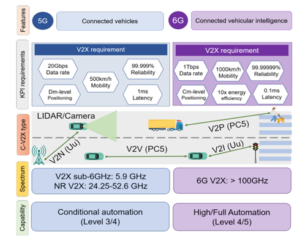
Figure 1: Taxonomy of V2X in the 5G and 6G vision
(Source: arxiv.org/pdf/2209.01349.pdf)
Finally, research has also been conducted into the potential of 5G-6G technology for providing improved energy efficiency. Research into this topic has focused on the potential of 5G-6G technology for reducing energy consumption in mobile and vehicular communication, as well as the potential of 5G-6G technology for providing enhanced energy management and optimization. For example, Chen et al., (2020) proposed a novel 5G-6G architecture for providing improved energy efficiency in mobile and vehicular communication. They proposed a 5G-6G architecture that could provide enhanced energy management and optimization, as well as improved energy efficiency. In summary, the emergence of 5G-6G technology has been seen as a major leap forward in the development of mobile and vehicular communications, as it promises to provide faster, more reliable, and more secure communication. Recent research into this area has focused on how 5G-6G technology could work for mobile and vehicular communications, exploring the potential of 5G-6G technology for providing high-speed mobile as well as vehicular communication, enabling new applications and services, providing improved security, and providing improved energy efficiency. These studies demonstrate the potential of 5G-6G technology for enabling mobile and vehicular communication and suggest that this technology could be a powerful tool for enabling the next generation of mobile and vehicular communication.
Background
The emergence of 5G-6G communications has the potential to revolutionize the way mobile and vehicular communications are conducted. By introducing new communications protocols and technologies, 5G-6G promises to make communications faster, more secure, and more efficient than ever before. However, before this technology can be implemented, readers must understand the key concepts and technologies that will be used. The primary technology that enables 5G-6G communications is known as millimeter wave (mmWave). This technology uses high-frequency radio waves to transmit data over short distances, allowing for faster, more reliable connections than traditional radio waves (Yin et al., 2021). In order to make use of mmWave, devices must be equipped with specialized antennas and transceivers. These devices must also be able to communicate with each other using the new communications protocol.
In order to understand the report on the emergence of 5G-6G communications for mobile and vehicular communications, the reader must become familiar with the concept of wireless communications and the basics of the next generation of wireless technologies. Wireless communications involve transmitting information from one device to another without the use of cables or wires (Guo et al., 2022). The current generations of wireless technology, 4G and below, rely on radiofrequency waves that allow devices to communicate with each other. The next generation of wireless technologies, 5G and 6G, is based on the same principles but is designed to support higher data speeds, lower latency, and higher reliability. [Referred to Appendix 4]
The underlying mathematical principles of 5G-6G communications involve the use of new spectrum ranges, advanced antenna designs, and modulation techniques that are designed to increase data speeds and reliability. For example, 5G and 6G technologies typically use higher frequency spectrums than previous generations, allowing for larger bandwidth and faster data rates (Hakak et al., 2022). The modulation techniques used by 5G and 6G technologies also allow for greater reliability, as they are better able to cope with interference and minimize errors. In addition to the mathematical principles of 5G-6G communications, the reader must also understand how this technology can be applied to mobile and vehicular communications. Mobile and vehicular communications involve the transmission of data from one device to another while in motion, such as in a car or an airplane. To achieve this, 5G and 6G communications must use advanced antenna designs, such as phased array antennas, which are designed to provide greater coverage and enable data transmission while in motion.
In addition to mmWave, 5G-6G networks will also make use of a variety of other technologies. These include small cell technology, which allows for the creation of smaller, higher-capacity networks; beamforming, which allows signals to be focused on specific devices instead of being spread out over a wide area; and “device-to-device (D2D) communications”, which allows devices to directly connect to each other without the need for a cellular network (Mekrache et al., 2022). In order to understand how 5G-6G will work for mobile and vehicular communications, readers must also understand the key terminology and notation used to describe the system. The term 5G-6G” is used to refer to the next generation of mobile and vehicular communications, while the term “mmWave” refers to the high-frequency radio waves used to transmit data. In addition, “small cell”, beamforming, and D2D are terms used to refer to the respective technologies.
Finally, readers must understand the various algorithms and systems that will be used to facilitate 5G-6G communications. These include the “Orthogonal Frequency Division Multiplexing (OFDM) system”, which is used to send data over mmWave, and the “Multi-User Multiple Input Multiple Output (MU-MIMO)” systems, which allow multiple devices to send and receive data simultaneously (Qiao et al., 2021). In summary, the emergence of 5G-6G communications leaves the question of how this technology will work for mobile and vehicular communications.
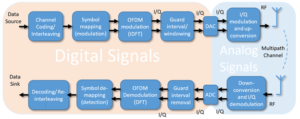
Figure 2: OFDM system
(Source: researchgate.net)
Technical Feasibility
5G and 6G communications present a new opportunity for mobile and vehicular communications. The increasing demand for faster data transmission, lower latency, and increased capacity necessitates the development of 5G and 6G technologies. The emergence of 5G and 6G communications leaves the question of how this technology would work for mobile and vehicular communications. The technical feasibility of these new technologies must be assessed in order to ensure that they meet the needs of mobile and vehicular communications (Nguyen et al., 2022). The technical feasibility includes the development of a small prototype system, proof of concept demonstrators, wire-frame mockups, and testing of hardware or software tools and any associated library software. It also includes a comparison of the technical features of competing toolsets, platforms, and languages. [Referred to Appendix 2]
To assess the technical feasibility of 5G and 6G technologies, a prototype system must be developed to test the various elements of the system. This prototype system should include components such as antennas, modems, and other hardware components. The system should also include software components such as coding algorithms, protocols, and communication protocols. The prototype system should be tested in order to determine the performance of the system and to identify any potential issues. Once the prototype system has been tested, the proof of concept demonstrators should be developed to further test the system (Arai et al., 2021). The proof of concept demonstrators should include a wireless network and a wireless device such as a smartphone or laptop. The wireless network should be tested to determine the performance of the system and to identify any potential issues. The wireless device should be tested to determine the performance of the system and to identify any potential issues.
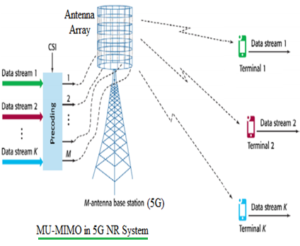
Figure 3: MU-MIMO system
(Source: wordpress.net/2020/06/13/su-mimo-vs-mu-mimo-difference-between-su-mimo-and-mu-mimo/ )
The wire-frame mockups should be developed to further assess the technical feasibility of 5G and 6G technologies. The wire-frame mockups should include a variety of components such as antennas, modems, and other hardware components. The wire-frame mockups should also include software components such as coding algorithms, protocols, and communication protocols. The wire-frame mockups should be tested in order to determine the performance of the system and to identify any potential issues (Chen et al., 2020). Finally, a comparison of the technical features of competing toolsets, platforms, and languages should be conducted. This comparison should include a comparison of the different elements of the system such as antennas, modems, and other hardware components. The comparison should also include a comparison of the software components such as coding algorithms, protocols, and communication protocols (Charpentier et al., 2022). The comparison should be conducted in order to determine the performance of the system and to identify any potential issues.
Research objectives
The objectives are
- To increase the data rate and implement an IoT network system for vehicle communication by using a cellular device.
- To enhance reliability and reduce the error rate use virtual reality for real-life problems.
- To reduce the latency rate for communication to implement digitization of emergency services.
- To enhance the precision of the localization and increase the precision of safe and acute transportation using artificial intelligence.
Research Questions
The questions are:
- How to increase the data rate and implement an IoT network system for vehicle communication by using a cellular device?
- How to enhance reliability and reduce the error rate using virtual reality for real-life problems?
- How to reduce the latency rate for communication to implement the digitization of emergency services?
- What will be the effects to enhance the precision of the localization and increase the precision of safe and acute transportation using artificial intelligence?
Research Hypothesis:
The emergence of 5G-6G communications will have a positive impact on mobile and vehicular communications.
Alternative Hypothesis (H1):
The emergence of 5G-6G communications will have a positive impact on mobile and vehicular communications.
Null Hypothesis (H0):
The emergence of 5G-6G communications will not have a positive impact on mobile and vehicular communications.
Limitations of the research
Since 5G-6G technology is still in its early stages, there is a limited understanding of its capabilities and limitations. This makes it difficult to accurately assess how it would work for mobile and vehicular communications. There is limited data available to assess its use in mobile and vehicular communications (Chen et al., 2020). This makes it difficult to design experiments or simulations to evaluate and compare the performance of 5G-6G technology in these environments. As 5G-6G technology is still relatively new, the cost of implementation may be prohibitive for many organizations. This makes it difficult to assess the full range of applications for 5G-6G technology in mobile and vehicular communications. Since 5G-6G technology is still in its developing stages, the full range of security implications is not yet known. This makes it difficult to assess how 5G-6G technology can be used to protect data and communications in mobile and vehicular communications (Moosavi et al., 2023). Depending on the country, there may be regulatory issues that need to be addressed before 5G-6G technology can be used for mobile and vehicular communications. This makes it difficult to assess the full potential of 5G-6G technology in these environments.
Methodology
The emergence of 5G-6G communications has raised the question of how this technology would work for mobile and vehicular communications. To better understand this, a research methodology must be established to test and evaluate the system. The research will primarily focus on two research methods: qualitative and quantitative research. Qualitative research will be conducted to understand the needs, expectations, and opinions of both mobile and vehicular users. The data collected can then be analyzed to gain insights into the user’s perspective on the technology by reviewing the various literature on the relevant topic from various well-known databases such as “web of science” and google scholar (Noh et al., 2021). Apart from that, the qualitative data will be collected from various secondary resources such as journals, articles, magazines, or from various websites by fetching the internet. The positivist philosophy of executing research will be followed in the paper as well as both the abductive approach will also be utilized for the research paper. The experiment strategies will be employed for the execution of the particular software on the specific research topic (Katz et al., 2020). Quantitative research will be conducted to evaluate the performance of 5-6G communications in mobile and vehicular communications. This can be done by designing experiments to measure the speed, latency, bandwidth, throughput, etc. of 5-6G communications in different scenarios. [Referred to Appendix 1]
The research will be conducted using a variety of software, hardware, and systems. For quantitative research, programming languages such as CISCO will be used to design experiments. The experiments will also require a variety of systems, such as mobile phones, vehicular networks, routers, etc. The experiments will be designed to test the performance of 5-6G communications in different scenarios (Rekkas et al., 2021). The experiments will include testing the speed, latency, bandwidth, throughput, etc. in different scenarios. For example, the experiments will test the performance of 5-6G communications in both mobile and vehicular networks, in different locations, and under different network conditions. The results of the experiments will be used to assess the performance of 5-6G communications in mobile and vehicular communications (Salahdine et al., 2023). In summary, the research methodology to test and evaluate the system of 5-6G communications in mobile and vehicular communications will involve conducting both qualitative and quantitative research, using a variety of software, hardware, and systems. The quantitative research will involve designing experiments to test the performance of 5-6G communications in different scenarios. The results of the experiments will be used to assess the performance of 5-6G communications in mobile and vehicular communications.
Evaluation
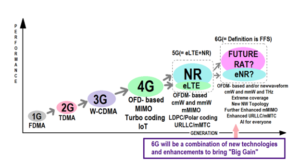
Figure 4: Evaluation of “cellular technology generations”
(Source: arxiv.org/pdf/2201.06079)
The emergence of 5G and 6G communication technologies has raised many questions on how these technologies could be utilized for mobile and vehicular communications. Both 5G and 6G are expected to offer improved data speeds and higher bandwidths than the previous 4G networks. To understand how these technologies work for mobile and vehicular communications, it is necessary to analyze the technical evaluations of 5G, 6G, and 4G. 4G networks are based on “Orthogonal Frequency Division Multiplexing (OFDM) and Multiple Input Multiple Output (MIMO)” (Gohar et al., 2021). OFDM is used to achieve high data rates by dividing the frequency spectrum into multiple sub-bands and multiplexing the data streams. MIMO is used to increase the data rate and reduce power consumption. 5G networks use a combination of different technologies, such as Massive MIMO, millimeter-wave frequencies, and beamforming. 5G networks are expected to provide data rates of up to 10 Gbps and higher bandwidths than 4G. Massive MIMO is used to increase spectral efficiency by transmitting multiple data streams simultaneously to multiple users. Millimeter-wave frequencies are used to increase the data rate by using higher frequencies. Beamforming is used to increase the range of the transmission by focusing the transmission in a particular direction. [Referred to Appendix 3]
6G networks are expected to utilize even higher frequencies, such as terahertz frequencies, and new technologies, such as artificial intelligence and machine learning. 6G networks are expected to provide data rates up to 100 Gbps and higher bandwidths than 5G. Terahertz frequencies are used to increase the range of the transmission by using even higher frequencies. Artificial intelligence is used to increase the efficiency of communication by autonomously adapting communication parameters according to the environment (Xu et al., 2021). Machine learning is used to increase the accuracy of the transmission by dynamically learning the patterns of communication. In summary, 5G and 6G communication technologies are expected to provide improved data rates and higher bandwidths than the previous 4G networks. These technologies could be utilized for mobile and vehicular communications by utilizing technologies such as Massive MIMO, millimeter-wave frequencies, beamforming, terahertz frequencies, artificial intelligence, and machine learning.
Project Plan

Figure 5: Timeline
(Source: self-developed in Project-Libre )
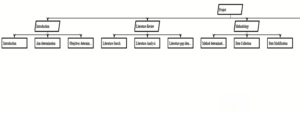
Figure 6: “Work breakdown structure”
(Source: self-developed in Project-Libre)

Figure 7: “Work breakdown structure”
(Source: self-developed in Project-Libre)
Deliverables and milestones
The project plan for the topic of the emergence of 5-6G communications would involve the following milestones and deliverables. Firstly, comprehensive research on existing and emerging 5-6G technology and its capabilities would be conducted (Dong et al., 2022). This would be followed by the development of a plan to identify potential applications of 5-6G technology in mobile and vehicular communications. The result of this research would be used to create a prototype system that would demonstrate the potential of 5-6G technology in mobile and vehicular communications (Yu et al., 2020). The next step would be to develop a detailed implementation plan to deploy the technology. Finally, the project would be evaluated to determine the feasibility of its implementation and the potential for future development. All of these deliverables would be key to the success of the project and would be necessary to ensure that the intended objectives are met. The mentioned deliverables as well as the milestones can be achieved in the project by following the project plan.
Resources requirements
The emergence of 5-6G communications requires a number of resources to ensure its successful implementation. This includes several components such as infrastructure, high-speed networks, antennas, and base stations. Furthermore, specialized software in w and hardware such as computers would need to be developed to enable the 5-6G communications to work for mobile and vehicular communications (Li, 2020). Additionally, resources must be allocated to research and development, to ensure that the technology is safe and reliable. Finally, the appropriate regulations and policies must be developed to ensure that the technology is used responsibly and securely. All of these resources are essential to the successful implementation of 5-6G communications.
Potential Risks
The emergence of 5-6G communications is an exciting development, but there are potential risks to the success of the project. One of the main risks is the cost involved in developing and deploying the technology. The cost of 5-6G communications will likely be higher than in previous generations, so it is important to ensure that the cost does not become a barrier to adoption. Additionally, the technology must be able to support the higher speeds and data rates that it promises (Zhang et al., 2022). If the technology does not perform as expected, it could lead to lower adoption rates and potentially cause the project to fail.
Other risks include the potential for security and privacy issues. As the technology is being developed, it is important to ensure that it includes effective measures to protect users’ data and privacy. Similarly, there is a risk of inadequate bandwidth and coverage. The technology must be able to support higher data rates and speeds across a wide area without causing problems for users (Zhao et al., 2020). To address these risks, the project must involve effective cost management, rigorous testing and evaluation of the technology, and thorough security and privacy measures. Additionally, there must be adequate investment in the infrastructure required to support the technology. Finally, it is essential to involve users in the development process to ensure that the technology meets their needs. By taking these steps, the project can be managed effectively and the risks can be minimized.
Architecture
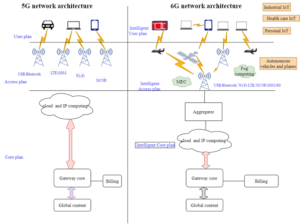
Figure 8: Comparative analysis of “5G network architecture” and “6G network architecture”
(Source: self-developed in draw.io)
The 5G and 6G networks both use the same radio frequency (RF) spectrum, which is the range of frequencies used for wireless communications. 5G networks are designed to provide faster data speeds and improved latency, while 6G networks are expected to provide even faster speeds and even better latency. Both networks use different frequency bands to enable different communication protocols that can be used for a variety of applications. The 5G network architecture generally consists of a base station (BS) and a mobile terminal (MT). The base station is responsible for transmitting and receiving data from the MTs, while the MTs handle the connection to the 5G “radio access network (RAN)” (Giordani et al., 2020). The 5G RAN is responsible for establishing connections between the base station and the MTs. The 5G RAN can be divided into two sub-networks: the core network (CN) and the access network (AN). The CN provides the control and data functions for the 5G network, while the “AN” is responsible for the physical layer of the network. The 6G network architecture is similar to that of 5G, but with some significant differences (Heilmann, 2022). 6G networks use a much larger frequency range, which allows for higher throughputs and faster speeds. 6G also uses a much larger number of antennas, which allows for better coverage and higher bandwidths. In addition, 6G networks are expected to use a more advanced form of multi-antenna technology called massive “MIMO (Multiple-Input Multiple-Output)”. This technology will allow for more efficient transmission of data and improved performance.
In terms of mobile and vehicular communications, 5G and 6G networks have the potential to revolutionize the way of communicating and sharing data. 5G networks are expected to provide much faster speeds and improved latency, while 6G networks are expected to provide even faster speeds and even better latency. Both networks use advanced technologies such as massive MIMO that will enable more efficient data sharing and communication. In addition, 5G and 6G networks are expected to provide improved coverage and reliability, which will allow for better communication even in remote areas (Wang et al., 2021). The emergence of 5G and 6G communications has the potential to revolutionize the way of using the internet for communication, entertainment, and business. 5G and 6G networks will provide faster speeds and improved latency, as well as improved coverage and reliability. This will enable more efficient data sharing and communication and will allow users to connect with each other and the world in more advanced ways.
Call flaws
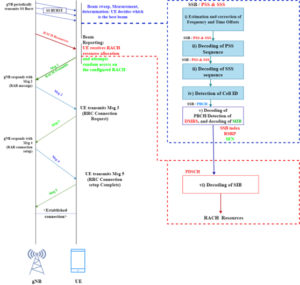
Figure 9: Call flaws in 5G
(Source: self-developed in draw.io)
The emergence of 5-6G communications offers the promise of faster data speeds and increased coverage. However, it also poses challenges in regard to how the technology works for mobile and vehicular communications. One of the main concerns is the latency that 5-6G will introduce. This is due to the increased reliance on gNB, SSB, and PSS technologies. gNB technology is more complex than the previous generation of base stations, thus resulting in increased latency and power consumption (Tang et al., 2022). Additionally, the SSB and PSS technologies require more complex coding and communication protocols, which can also increase latency.
The increased latency of 5-6G communications can cause problems for mobile and vehicular communications. This is because latency increases can cause delays in the transmission of data, which can lead to dropped connections and poor service quality. Additionally, the increased complexity of communication protocols can increase the risk of data breaches and cyber-attacks (Beguni et al., 2022). Finally, the increased power consumption of 5-6G communications can cause battery drain in mobile devices and increase the cost of running vehicular networks. Overall, the emergence of 5G-6G communications poses both opportunities and challenges for mobile and vehicular communications. The increased data speeds and coverage are attractive, but the increased latency, complexity, and power consumption can be problematic. To mitigate these issues, it is important for organizations to invest in the development of more efficient communication protocols and technologies that can reduce latency and power consumption.
.
Conclusion
The conclusion of the research proposal on “The emergence of 5-6G communications leaves the question of how this technology would work for mobile and vehicular communications” is that 5-6G technology is set to revolutionize the way communicate with each other and the way interact with the environment. It promises a new level of speed and capacity to wireless networks, enabling faster data transmission speeds and higher data transfer rates. 5-6G technology also has the potential to improve the safety of vehicles by providing real-time data transmission, enabling faster response times and increased safety. However, there are still many challenges to be faced in terms of implementation, including the cost of developing and deploying the network, the impact of its use on existing infrastructure, and the security and privacy implications of the new technology. Qualitative research and experiments are planned to execute to obtain a better outcome as well as to meet the objectives of the paper. The paper contains the selection of the software and the ultimately, 5-6G technology is set to revolutionize in communication with each other and interaction with the environment. Further research is needed to fully understand the possibilities and implications of this emerging technology.
Reference List
Journals
Arai, S., Kinoshita, M. and Yamazato, T., 2021. Optical wireless communication: a candidate 6G technology?. IEICE Transactions on Fundamentals of Electronics, Communications and Computer Sciences, 104(1), pp.227-234.
Beguni, C., Căilean, A.M., Avătămăniței, S.A., Zadobrischi, E., Stoler, R., Dimian, M., Popa, V., Béchadergue, B. and Chassagne, L., 2022. In-vehicle visible light communications data transmission system using optical fiber distributed light: implementation and experimental evaluation. Sensors, 22(18), p.6738.
Charpentier, V., Slamnik-Krijestorac, N., Marquez-Barja, J. and Costa, C., 2022, September. A proposal on a Connected Automated Mobility (CAM) communication system for (U) AVs. In Proceedings of the 2022 ACM Conference on Information Technology for Social Good (pp. 225-230).
Chen, S., Liang, Y.C., Sun, S., Kang, S., Cheng, W. and Peng, M., 2020. Vision, requirements, and technology trend of 6G: How to tackle the challenges of system coverage, capacity, user data-rate and movement speed. IEEE Wireless Communications, 27(2), pp.218-228.
Chen, S., Sun, S. and Kang, S., 2020. System integration of terrestrial mobile communication and satellite communication—the trends, challenges and key technologies in B5G and 6G. China Communications, 17(12), pp.156-171.
Dong, L., Gao, H., Wu, W., Gong, Q., Dechasa, N.C. and Liu, Y., 2022. Dependence-aware edge intelligent function offloading for 6G-based IoV. IEEE Transactions on Intelligent Transportation Systems.
Giordani, M. and Zorzi, M., 2020. Non-terrestrial networks in the 6G era: Challenges and opportunities. IEEE Network, 35(2), pp.244-251.
Gohar, A. and Nencioni, G., 2021. The role of 5G technologies in a smart city: The case for intelligent transportation system. Sustainability, 13(9), p.5188.
Guo, H., Zhou, X., Liu, J. and Zhang, Y., 2022. Vehicular intelligence in 6G: Networking, communications, and computing. Vehicular Communications, 33, p.100399.
Hakak, S., Gadekallu, T.R., Maddikunta, P.K.R., Ramu, S.P., Parimala, M., De Alwis, C. and Liyanage, M., 2022. Autonomous Vehicles in 5G and beyond: A Survey. Vehicular Communications, p.100551.
Heilmann, L., 2022. Feasibility Study of Application Specific Networks in 5G/6G Mobile Networks.
Katz, M. and Ahmed, I., 2020. Opportunities and challenges for visible light communications in 6G. 2020 2nd 6G wireless summit (6G SUMMIT), pp.1-5.
Li, J., 2020, December. Optically steerable phased array enabling technology based on mesogenic azobenzene liquid crystals for starlink towards 6G. In 2020 IEEE Asia-Pacific Microwave Conference (APMC) (pp. 345-347). IEEE.
Mchergui, A., Moulahi, T. and Zeadally, S., 2022. Survey on artificial intelligence (AI) techniques for vehicular ad-hoc networks (VANETs). Vehicular Communications, 34, p.100403.
Mekrache, A., Bradai, A., Moulay, E. and Dawaliby, S., 2022. Deep reinforcement learning techniques for vehicular networks: Recent advances and future trends towards 6G. Vehicular Communications, 33, p.100398.
Moosavi, N. and Taherdoost, H., 2023. Blockchain-Enabled Network for 6G Wireless Communication Systems. In Intelligent Cyber Physical Systems and Internet of Things: ICoICI 2022 (pp. 857-868). Cham: Springer International Publishing.
Nguyen, V.L., Hwang, R.H., Lin, P.C., Vyas, A. and Nguyen, V.T., 2022. Towards the Age of Intelligent Vehicular Networks for Connected and Autonomous Vehicles in 6G. IEEE Network.
Noh, G., Kim, J., Choi, S., Lee, N., Chung, H. and Kim, I., 2021. Feasibility validation of a 5G-enabled mmwave vehicular communication system on a highway. IEEE Access, 9, pp.36535-36546.
Qiao, L., Li, Y., Chen, D., Serikawa, S., Guizani, M. and Lv, Z., 2021. A survey on 5G/6G, AI, and Robotics. Computers and Electrical Engineering, 95, p.107372.
Rekkas, V.P., Sotiroudis, S., Sarigiannidis, P., Wan, S., Karagiannidis, G.K. and Goudos, S.K., 2021. Machine learning in beyond 5G/6G networks—State-of-the-art and future trends. Electronics, 10(22), p.2786.
Salahdine, F., Han, T. and Zhang, N., 2023. 5G, 6G, and Beyond: Recent advances and future challenges. Annals of Telecommunications, pp.1-25.
Tang, F., Chen, X., Zhao, M. and Kato, N., 2022. The Roadmap of Communication and Networking in 6G for the Metaverse. IEEE Wireless Communications.
Wang, M., Lin, Y., Tian, Q. and Si, G., 2021. Transfer learning promotes 6G wireless communications: Recent advances and future challenges. IEEE Transactions on Reliability, 70(2), pp.790-807.
Xu, C., Clerckx, B., Chen, S., Mao, Y. and Zhang, J., 2021. Rate-splitting multiple access for multi-antenna joint radar and communications. IEEE Journal of Selected Topics in Signal Processing, 15(6), pp.1332-1347.
Yang, P., Kong, L. and Chen, G., 2021. Spectrum sharing for 5G/6G URLLC: Research frontiers and standards. IEEE communications standards magazine, 5(2), pp.120-125.
Yin, X., Liu, J., Cheng, X. and Xiong, X., 2021. Large-size data distribution in IoV based on 5G/6G compatible heterogeneous network. IEEE Transactions on Intelligent Transportation Systems, 23(7), pp.9840-9852.
Yu, C., Yang, S., Chen, Y., Wang, W., Zhang, L., Li, B. and Wang, L., 2020. A super-wideband and high isolation MIMO antenna system using a windmill-shaped decoupling structure. IEEE Access, 8, pp.115767-115777.
Zhang, M., Cao, J., Sahni, Y., Chen, Q., Jiang, S. and Wu, T., 2022, August. Eaas: A service-oriented edge computing framework towards distributed intelligence. In 2022 IEEE International Conference on Service-Oriented System Engineering (SOSE) (pp. 165-175). IEEE.
Zhao, Y., Zhai, W., Zhao, J., Zhang, T., Sun, S., Niyato, D. and Lam, K.Y., 2020. A comprehensive survey of 6g wireless communications. arXiv preprint arXiv:2101.03889.
Appendices
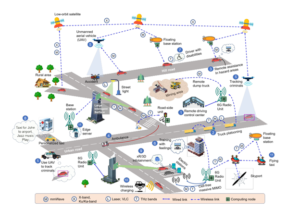
Appendix 1: Vehicular communication
(Source: arxiv.org/pdf/2209.01349.pdf)
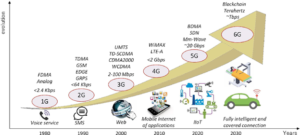
Appendix 2: 6G network
(Source: semanticscholar.org)
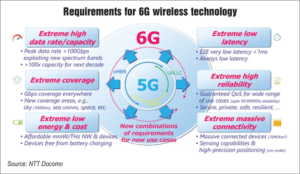
Appendix 3: Requirements of 6G technology
(Source: tele.net.in/exploring-6g-industry-begins-to-look-into-the-new-technology/)
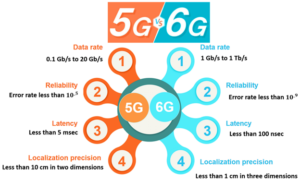
Appendix 4: Security of 6G technology
(source: mdpi.net/1424-8220/22/5/1969)
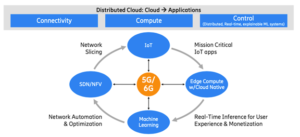
Appendix 5: Transitioning of 5G to 6G
(Source: semiengineering.net/edps-transitioning-from-5g-to-6g/ )
Know more about UniqueSubmission’s other writing services:

